
Exocrine glands are glands that produce and secrete substances onto an epithelial surface by way of a duct. Examples of exocrine glands include sweat, salivary, mammary, ceruminous, lacrimal, sebaceous, and mucous. Exocrine glands are one of two types of glands in the human body, the other being endocrine glands, which secrete their products directly into the bloodstream. The liver and pancreas are both exocrine and endocrine glands; they are exocrine glands because they secrete products—bile and pancreatic juice—into the gastrointestinal tract through a series of ducts, and endocrine because they secrete other substances directly into the bloodstream.

Nose-picking is the act of extracting nasal mucus with one's finger (rhinotillexis) and may include the subsequent ingestion of the extracted mucus (mucophagy).
This action is condemned in most cultures; societies try to prevent development of the habit and attempt to break it if already established. Mucophagy is a source of mockery and entertainment in the media.

The Eustachian tube, also known as the auditory tube or pharyngotympanic tube, is a tube that links the nasopharynx to the middle ear. It is a part of the middle ear. In adult humans the Eustachian tube is approximately 35 mm (1.4 in) long and 3 mm (0.12 in) in diameter. It is named after the sixteenth-century Italian anatomist Bartolomeo Eustachi.
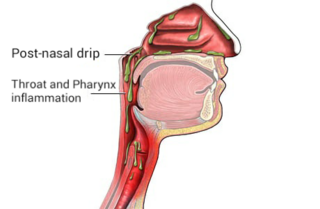
Post-nasal drip occurs when excessive mucus is produced by the nasal mucosa. The excess mucus accumulates in the back of the nose and eventually the throat once it drips down the back of the throat. It can be caused by rhinitis, sinusitis, gastroesophageal reflux disease (GERD), or by a disorder of swallowing. Other causes can be allergy, cold, flu, and side effects from medications.

Rhinorrhea or rhinorrhoea is a condition where the nasal cavity is filled with a significant amount of mucus fluid. The condition, commonly known as a runny nose, occurs relatively frequently. Rhinorrhea is a common symptom of allergies or certain viral infections, such as the common cold. It can be a side effect of crying, exposure to cold temperatures, cocaine abuse or withdrawal, such as from opioids like methadone. Treatment for rhinorrhea is not usually necessary, but there are a number of medical treatments and preventive techniques available.

The pyramid-shaped maxillary sinus is the largest of the paranasal sinuses, and drains into the middle meatus of the nose.

Oral mucocele is a clinical term for two related phenomena: mucus extravasation phenomenon and mucus retention cyst. Other names include mucous extravasation cyst, mucous cyst of the oral mucosa, and mucous retention and extravasation phenomena.
In physiology, the term serous fluid or serosal fluid is any of various body fluids resembling serum, that are typically pale yellow and transparent and of a benign nature. The fluid fills the inside of body cavities. Serous fluid originates from serous glands, with secretions enriched with proteins and water. Serous fluid may also originate from mixed glands, which contain both mucous and serous cells. A common trait of serous fluids is their role in assisting digestion, excretion, and respiration.
The mucous membrane of the soft palate is thin, and covered with stratified squamous epithelium on both surfaces, except near the pharyngeal ostium of the auditory tube, where it is columnar and ciliated.

N-Acetylneuraminic acid is the predominant sialic acid found in human cells, and many mammalian cells. Other forms, such as N-Glycolylneuraminic acid, may also occur in cells.
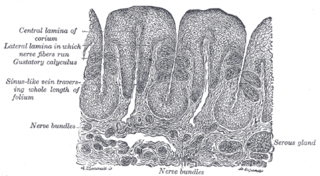
Mucous gland, also known as muciparous glands, are found in several different parts of the body, and they typically stain lighter than serous glands during standard histological preparation. Most are multicellular, but goblet cells are single-celled glands.
Mucophagy is feeding on mucus of fishes or invertebrates. It may also refer to consumption of mucus or dried mucus in primates.

The gastric mucosa is the mucous membrane layer of the stomach, which contains the glands and the gastric pits. In humans, it is about 1 mm thick, and its surface is smooth, soft, and velvety. It consists of simple columnar epithelium, lamina propria, and the muscularis mucosae.
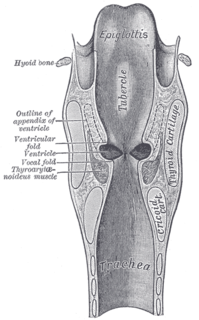
The laryngeal ventricle, is a fusiform fossa, situated between the vestibular and vocal folds on either side, and extending nearly their entire length. There is also a sinus of Morgagni in the pharynx.

Foveolar cells or surface mucous cells are mucus-producing cells which cover the inside of the stomach, protecting it from the corrosive nature of gastric acid. These cells line the gastric mucosa. The mucus-secreting cells of the stomach can be distinguished histologically from the intestinal goblet cells, another type of mucus-secreting cell.
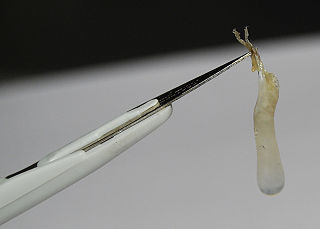
Dried nasal mucus, colloquially known as a boogie, snot, booger or bogey, is found in the nose. It is a result of drying of the normally viscous colloidal mucus, commonly known as snot.
Rectal discharge is intermittent or continuous expression of liquid from the anus. Normal rectal mucus is needed for proper excretion of waste. Otherwise, this is closely related to types of fecal incontinence but the term rectal discharge does not necessarily imply degrees of incontinence. Types of fecal incontinence that produce a liquid leakage could be thought of as a type of rectal discharge.
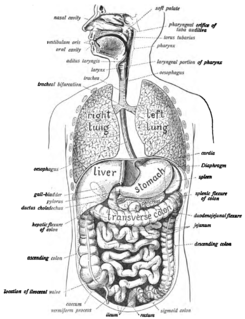
The human digestive system consists of the gastrointestinal tract plus the accessory organs of digestion. Digestion involves the breakdown of food into smaller and smaller components, until they can be absorbed and assimilated into the body. The process of digestion has many stages. The first stage is the cephalic phase of digestion which begins with gastric secretions in response to the sight and smell of food. The next stage starts in the mouth.














